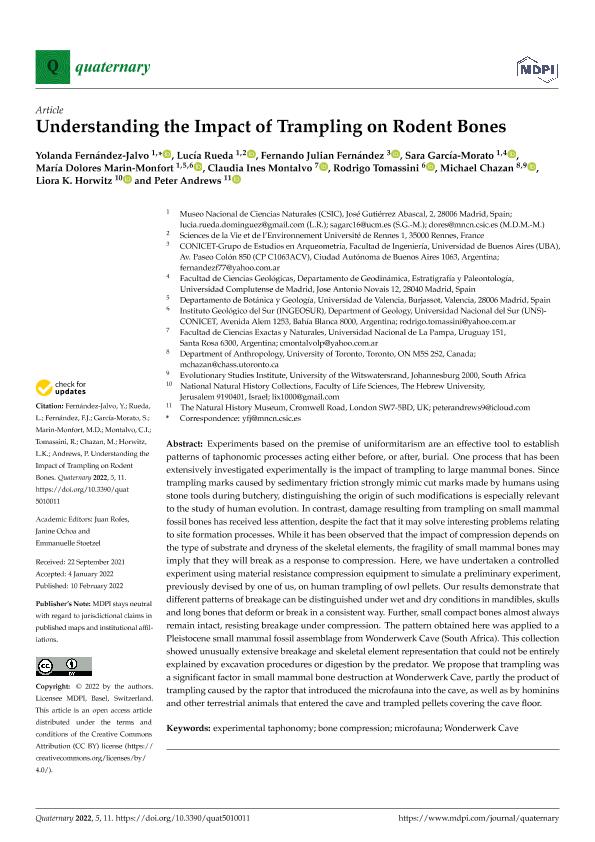Artículo
Understanding the Impact of Trampling on Rodent Bones
Fernández Jalvo, Yolanda; Rueda, Lucía; Fernández, Fernando Julián ; García Morato, Sara; Marin Monfort, María Dolores
; García Morato, Sara; Marin Monfort, María Dolores ; Montalvo, Claudia Inés; Tomassini, Rodrigo Leandro
; Montalvo, Claudia Inés; Tomassini, Rodrigo Leandro ; Chazan, Michael; Horwitz, Liora K.; Andrews, Peter
; Chazan, Michael; Horwitz, Liora K.; Andrews, Peter
 ; García Morato, Sara; Marin Monfort, María Dolores
; García Morato, Sara; Marin Monfort, María Dolores ; Montalvo, Claudia Inés; Tomassini, Rodrigo Leandro
; Montalvo, Claudia Inés; Tomassini, Rodrigo Leandro ; Chazan, Michael; Horwitz, Liora K.; Andrews, Peter
; Chazan, Michael; Horwitz, Liora K.; Andrews, Peter
Fecha de publicación:
03/2022
Editorial:
MDPI
Revista:
Quaternary
ISSN:
2571-550X
Idioma:
Inglés
Tipo de recurso:
Artículo publicado
Clasificación temática:
Resumen
Experiments based on the premise of uniformitarism are an effective tool to establish patterns of taphonomic processes acting either before, or after, burial. One process that has been extensively investigated experimentally is the impact of trampling to large mammal bones. Since trampling marks caused by sedimentary friction strongly mimic cut marks made by humans using stone tools during butchery, distinguishing the origin of such modifications is especially relevant to the study of human evolution. In contrast, damage resulting from trampling on small mammal fossil bones has received less attention, despite the fact that it may solve interesting problems relating to site formation processes. While it has been observed that the impact of compression depends on the type of substrate and dryness of the skeletal elements, the fragility of small mammal bones may imply that they will break as a response to compression. Here, we have undertaken a controlled experiment using material resistance compression equipment to simulate a preliminary experiment, previously devised by one of us, on human trampling of owl pellets. Our results demonstrate that different patterns of breakage can be distinguished under wet and dry conditions in mandibles, skulls and long bones that deform or break in a consistent way. Further, small compact bones almost always remain intact, resisting breakage under compression. The pattern obtained here was applied to a Pleistocene small mammal fossil assemblage from Wonderwerk Cave (South Africa). This collection showed unusually extensive breakage and skeletal element representation that could not be entirely explained by excavation procedures or digestion by the predator. We propose that trampling was a significant factor in small mammal bone destruction at Wonderwerk Cave, partly the product of trampling caused by the raptor that introduced the microfauna into the cave, as well as by hominins and other terrestrial animals that entered the cave and trampled pellets covering the cave floor.
Palabras clave:
BONE COMPRESSION
,
EXPERIMENTAL TAPHONOMY
,
MICROFAUNA
,
WONDERWERK CAVE
Archivos asociados
Licencia
Identificadores
Colecciones
Articulos(INGEOSUR)
Articulos de INST.GEOLOGICO DEL SUR
Articulos de INST.GEOLOGICO DEL SUR
Articulos(SEDE CENTRAL)
Articulos de SEDE CENTRAL
Articulos de SEDE CENTRAL
Citación
Fernández Jalvo, Yolanda; Rueda, Lucía; Fernández, Fernando Julián; García Morato, Sara; Marin Monfort, María Dolores; et al.; Understanding the Impact of Trampling on Rodent Bones; MDPI; Quaternary; 5; 1; 3-2022; 1-19
Compartir
Altmétricas



